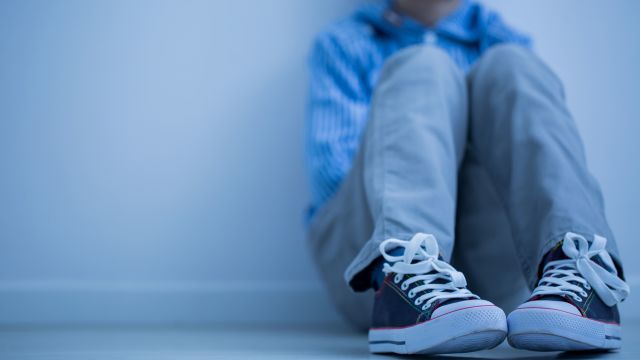Updated on March 7, 2024.
Following a steady rise since 2020, the number of suicides in the U.S. reached an all-time high in 2022, according to provisional data released by the Centers for Disease Control and Prevention (CDC). An estimated 49,449 people died by suicide last year—a 2.6 percent increase from 2021.
Adults ages 65 and older saw the largest increase in suicide deaths of any age group from 2021 to 2022, with an 8.1 percent rise to 10,433 deaths. Children and young adults 10 to 24, however, saw the largest decrease of any age group during that time with a decline of 8.4 percent, or suicide deaths, the CDC reports. Still, roughly 6,500 kids, teens, and young adults took their own lives last year.
“Today’s report underscores the depths of the devastating mental health crisis in America. Mental health has become the defining public health and societal challenge of our time. Far too many people and their families are suffering and feeling alone,” said U.S. Surgeon General Vivek Murthy, M.D., M.B.A. in an August 10 statement. “These numbers are a sobering reminder of how urgent it is that we further expand access to mental health care, address the root causes of mental health struggles, and recognize the importance of checking on and supporting one another.”
Meanwhile, a CDC study published in June found that the suicide rate among that age group has surged over the last two decades, rising 62 percent from 2007 to 2021. And in 2021, the largest increase in the rate of suicide—an 8 percent jump—occurred among males between 15 and 24-years old, the CDC reported in September 2022. One year earlier in 2020, suicide was the second leading cause of death among kids between 10 and 14-years old and the third leading cause of death among teens and young adults between 15 and 24.
“This is a growing trend that does not appear to be slowing down,” says Franklin Drummond, MD, a psychiatrist in Charleston, South Carolina. “I think it’s part of the reality of being a child today, and that’s a new concept for a lot of people.”
Even the very young may be vulnerable
Research into suicide in kids tends to focus on those 10 and older, in part because it can be difficult to determine suicidal intent in younger children. Other CDC data indicate that suicide in the youngest children is relatively rare, but in 2015, there were 413 confirmed cases of suicide in children aged 5 to 14, compared to 5,491 cases in teens and young adults aged 15 to 24.
Official numbers, though, may underestimate actual incidence, since cases of suicide—particularly those involving drug overdoses—may be underreported.
Factors that contribute to suicide in children
Risk factors for suicide in children and teenagers include the following:
Mental health issues (including depression, anxiety and substance abuse)
- Previous suicide attempts
- Family history of suicidal behavior or mental health issues
- Gay, lesbian or bisexual orientation or transgender identity
- History of physical or sexual abuse
- Exposure to violence
Other signs in children and teens that suggest a suicide attempt may be imminent include:
- Thoughts of suicidal or self-harm
- Feeling trapped, hopeless or purposeless
- Excessive anxiety, worry, fear or anger
- Withdrawal from friends, family and society
- Reckless behavior
- Mood changes
And the following factors may increase the likelihood of a suicide taking place:
- Access to weapons or other means of self-harm (such as medications or poisons)
- Alcohol and drug use
- Exposure to suicide (of a family member or friend)
- Social stress and isolation
Younger children may show different warning signs
It’s important to recognize that mental illness (a risk factor for suicide), may appear different in younger children than in adolescents, Dr. Drummond says.
A 2016 study published in Pediatrics looked at 699 suicides in elementary-aged children. It found that, among those children who had been diagnosed with a mental health problem, the younger children who died by suicide were more likely to have a diagnosis of attention-deficit disorder/attention-deficit hyperactivity disorder (ADD/ADHD). Older children, on the other hand, were more likely to be diagnosed with depression.
“The rate of completed suicide among the younger age group has a high correlation with ADD,” Drummond points out. “ADD can manifest as an increase in activity or appetite or as behavioral problems.” He notes that impulsivity—a hallmark of ADD—may contribute to suicide in younger children because it can result in acting on suicidal thoughts.
The majority of children who receive an ADD diagnosis will not attempt suicide or have suicidal thoughts, but it is nonetheless a risk factor worth contemplating.
The Pediatrics study found that while early teens aged 12 to 14 who died by suicide were more likely to leave behind a suicide note or have experienced problems with a romantic partner, younger kids ages 5 to 11 who took their own lives were more likely than teens to have had problems in relationships with family members and other friends. Both groups were equally likely to have expressed suicidal intent to someone else.
Other warning signs in younger children are often subtler than those seen in adolescents and teens. “I always try to alert people for a change in a child’s behavior that involves some sort of withdrawal or a change in attitude about other people,” Drummond says. Crying spells, becoming less verbal and displaying a lack of interest in familiar activities are also signals.
“These signs should be noted,” he says, “and there should be an intervention at that point.”
What to do if you see signs
The first thing to do if you detect warning signs of suicide is to talk directly to your child about it, Drummond advises. “Be open and try to make it non-threatening,” he says.
If you continue to suspect a risk for suicide, Drummond says it would be appropriate to reach out to a family therapist or counselor who focuses on children, or a child psychiatrist.
Communication and staying engaged with your child is key. “The way that families manage feelings and the more support that families provide can definitely help manage some of these stressors,” Drummond says. “Isolation of the individual is one of the big risk factors for a completed suicide.”
Your child’s primary care doctor may be enlisted to help, too. At the very least, your pediatrician can help identify warning signs and refer your child to a psychiatrist or other mental health professional.
Educators have a role to play, too. “Kids can present a different face at school than they do at home,” Drummond says, “and teachers can help identify acute behavioral changes.”
For example, teachers may be able to discern changes in a child’s interaction with peers or self-isolating behavior, which may be more obvious at school than at home. “Changes in academic or sports performance—when something suddenly becomes difficult for a child or when a child suddenly loses interest—are other signs that teachers should tune into,” Drummond says.
If a teacher detects signs like these, he or she can refer a student to a school counselor. “That will trigger a child psychiatrist visit or a mental health intervention,” he says.
When children display suicidal behavior—that is, an attempt in the moment to inflict self-harm—they should be kept under close watch in a safe environment without the means to hurt themselves. They should then be promptly referred to a mental health professional or taken to an emergency room for evaluation and treatment.
If the crisis is urgent—you fear that a child is in immediate danger—don’t wait for an appointment with a psychiatrist or a therapist. Seek help right away by calling the National Suicide Prevention Lifeline at 1-800-273-8255, call, text, or chat 988, or dial 911.
Children face unique pressures today
A June 2018 Pediatrics study found the frequency of hospital visits for suicide attempts and ideation appeared to follow the school schedule: lowest during the summer months and highest in the fall and spring.
“It could be that it’s more stressful to be in school than it used to be,” Drummond says. “While academic standards and expectations have gone up, kids are being exposed to other stressful things—including violence, negativity, and bullying.”
And while technology and culture are not the only contributors to suicide in children, they are factors that have been evolving and accumulating rapidly in recent years.
“Social media opens up a different world, so kids are exposed to the idea of suicide at a much younger age,” Drummond says. “There’s a lot of content out there that uses language like, ‘You should kill yourself.' Unfortunately, that seems to have an impact on children.”
There is also evidence that bullying may contribute to the observed increase in hospital visits related to suicide. Drummond emphasizes that children, parents, and educators need to be clear-eyed about its dangers.
“Bullying used to be much more observable because it was out in the open, on the playground,” Drummond says. “Now, it can be silent, virtual and a lot of parents have no idea that this level of negative pressure is going on.”
Here, too, teachers can also play an important role, because even if they don’t witness overt acts of bullying, they will often be the first ones to observe its effects on students.
“I think these factors have a lot to do with these disturbing trends we see in mental health in our younger kids,” says Drummond.
His takeaway? “Don't underestimate their seriousness. And address them as effectively as possible so that we can come together to do our best on behalf of our children.”







